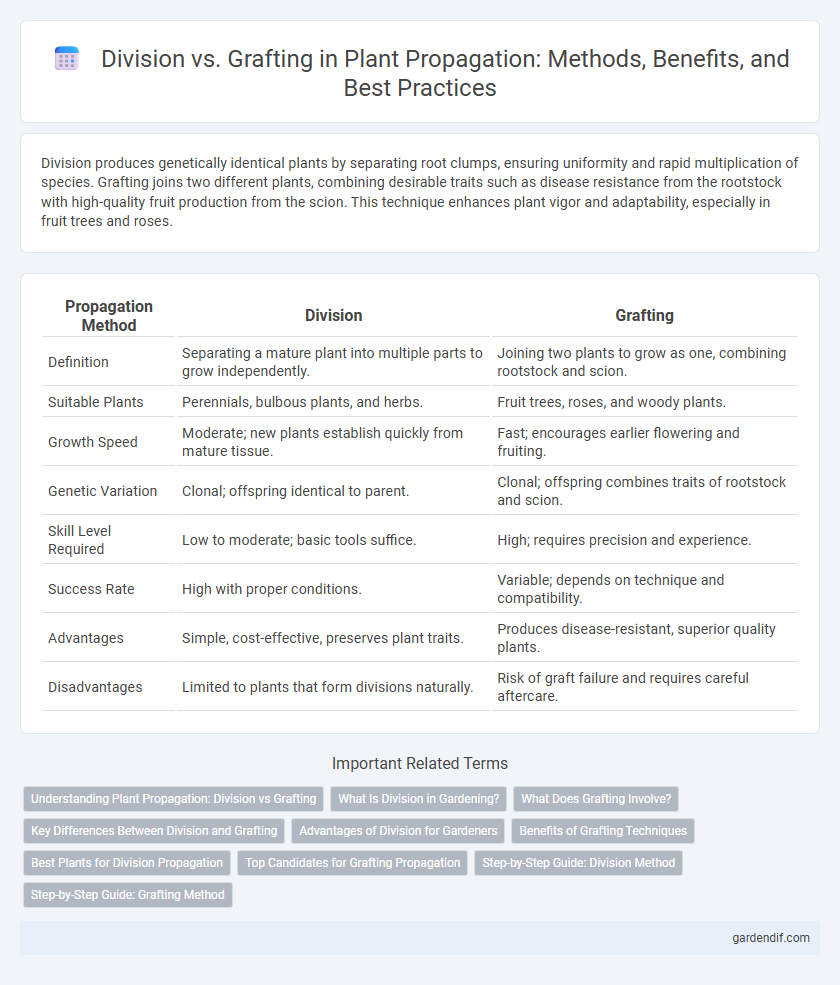
Division vs Grafting Illustration
Division produces genetically identical plants by separating root clumps, ensuring uniformity and rapid multiplication of species. Grafting joins two different plants, combining desirable traits such as disease resistance from the rootstock with high-quality fruit production from the scion. This technique enhances plant vigor and adaptability, especially in fruit trees and roses.
Table of Comparison
| Propagation Method | Division | Grafting |
|---|---|---|
| Definition | Separating a mature plant into multiple parts to grow independently. | Joining two plants to grow as one, combining rootstock and scion. |
| Suitable Plants | Perennials, bulbous plants, and herbs. | Fruit trees, roses, and woody plants. |
| Growth Speed | Moderate; new plants establish quickly from mature tissue. | Fast; encourages earlier flowering and fruiting. |
| Genetic Variation | Clonal; offspring identical to parent. | Clonal; offspring combines traits of rootstock and scion. |
| Skill Level Required | Low to moderate; basic tools suffice. | High; requires precision and experience. |
| Success Rate | High with proper conditions. | Variable; depends on technique and compatibility. |
| Advantages | Simple, cost-effective, preserves plant traits. | Produces disease-resistant, superior quality plants. |
| Disadvantages | Limited to plants that form divisions naturally. | Risk of graft failure and requires careful aftercare. |
Understanding Plant Propagation: Division vs Grafting
Division involves separating a mature plant into multiple sections, each capable of growing independently, making it ideal for herbaceous perennials and plants with clumping root systems. Grafting joins a scion (the desired plant variety) onto a rootstock to combine traits such as disease resistance and improved growth, commonly used in fruit trees and woody plants. Understanding plant propagation techniques is crucial for selecting division to maintain genetic consistency or grafting to enhance plant performance and adaptability.
What Is Division in Gardening?
Division in gardening is a propagation method that involves separating a mature plant into multiple sections, each with roots and shoots, to create new plants. This technique is commonly used for perennials, such as hostas and daylilies, to rejuvenate plants and control their spread. Division promotes rapid establishment and maintains the genetic identity of the parent plant, unlike grafting which combines tissues from two different plants.
What Does Grafting Involve?
Grafting involves joining two plant parts, the rootstock and the scion, to grow as one plant, ensuring the combined organism benefits from both rootstock's strong roots and scion's superior fruit or flower qualities. This method is commonly used in fruit trees, roses, and vines to propagate plants that do not root well from cuttings or to combine disease resistance with high-quality yields. Successful grafting requires precise alignment of the vascular cambium layers to facilitate nutrient and water transport between the grafted parts.
Key Differences Between Division and Grafting
Division involves separating a parent plant into multiple sections, each capable of growing independently, while grafting joins tissues from two different plants to grow as one. Division is commonly used for plants with multiple crowns or bulbs, promoting rapid multiplication, whereas grafting is preferred for combining desirable traits like disease resistance and improved fruit quality. The success of division depends on root system health, whereas grafting success relies heavily on cambium layer compatibility between rootstock and scion.
Advantages of Division for Gardeners
Division offers gardeners a straightforward propagation method that requires minimal specialized equipment, making it accessible for beginners and experienced horticulturists alike. It promotes faster establishment and growth since plants are split from mature specimens, which are already adapted to the local environment. Gardeners benefit from increased plant stock without waiting for seed germination, ensuring uniformity and preserving the parent plant's desirable traits.
Benefits of Grafting Techniques
Grafting techniques enhance plant propagation by enabling the combination of desirable traits from two different plants, such as disease resistance and superior fruit quality. This method accelerates maturity and improves uniformity in crops, leading to higher yields compared to traditional division. Grafting also facilitates propagation of plants that are difficult to root or divide, expanding horticultural possibilities.
Best Plants for Division Propagation
Plants best suited for division propagation include perennials such as hostas, daylilies, and irises, which naturally grow in clumps that can be separated easily. Division allows these plants to maintain genetic consistency and establish quickly in new locations. Unlike grafting, division is ideal for herbaceous plants with sturdy root systems that can thrive after being split.
Top Candidates for Grafting Propagation
Top candidates for grafting propagation include fruit trees such as apples, cherries, and peaches due to their compatibility and ability to combine desirable traits like disease resistance and fruit quality. Grapevines and citrus species also rank highly because grafting enhances vigor and adaptability to various soil conditions. Selection of rootstock and scion is critical, with exact matching ensuring successful graft union and improved overall plant performance.
Step-by-Step Guide: Division Method
The division method in plant propagation involves carefully separating a mature plant into multiple sections, each containing roots and shoots, to create new independent plants. Begin by digging up the entire plant and gently shaking off excess soil to expose the root system. Use a sharp knife or garden spade to divide the root clump into smaller sections, ensuring each division has healthy roots and shoots before replanting them in suitable soil conditions.
Step-by-Step Guide: Grafting Method
Grafting involves selecting healthy rootstock and a compatible scion, making precise cuts to join vascular cambium layers, and securing the union with grafting tape or wax to ensure successful nutrient exchange. Maintaining ideal environmental conditions such as humidity and temperature promotes callus formation and prevents desiccation during the healing process. Monitoring graft union development over weeks ensures a strong, viable plant that combines desired traits from both rootstock and scion.
Division vs Grafting Infographic

 gardendif.com
gardendif.com